This week we have another new member of the Trivelo team with James joining us providing a trusted review from another real athlete. Read through the Orca S7 Wetsuit Review that James has been testing for the past 8 weeks.
Introduction to James
Hi, I’m James. I am just a typical age grouper. I was never really into sport until I moved to Devon in my 20’s when I joined the local Rowing club with my brothers and fell in love the sport. This was a steppingstone and over the next few years I took up Surfing, Kayaking, Mountain biking and Hiking.
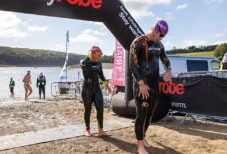
Who are Orca?
Former triathlon champion Scott Unsworth set up Performance Speedsuits Ltd in 1992 in Auckland, New Zealand. He decided to start manufacturing wetsuits after discovering that traditional wetsuits were not suitable for swimming. Unsworth was spurred by a passion to create better, faster wetsuits than those on the market. These wetsuits gained popularity and the company was eventually renamed “Orca”. Over the past two decades Orca have worked to evolve, innovate and perform with their athletes. Today, Orca is recognized as a leading brand amongst new entrant and professional triathletes around the globe.
If you are in the market for a new triathlon watch I am sure you will have considered the range from Garmin. If you need more insight and which to go for read our comparison of the Garmin Forerunner 965 v 955 v 945. Is it worth the premium for the latest model?
First impressions of the Orca S7
Opening the box, the wetsuit was very nicely presented and packed very well. It came with a pair of cotton gloves to help prevent the wetsuit getting damaged by fingernails when putting it on. I was struck by the bright colours on the arms which is an import addition to help people keep track of you in the water.
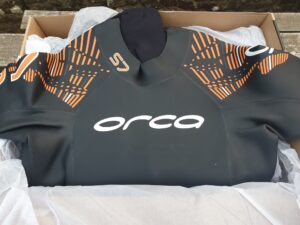
Size guide of the wetsuit
I’m 6’1” and just over 14st with a typical dad body shape the size 9 fitted perfectly for me. Normally I have to try a few sizes on to get the right fit, but the Orca size chart was really good. The only issue I have had with the fit is when I start to do the zip up. I have to pinch the sides at the low back together with my other hand to allow the zip to pass. Once it is past my muffin top the zip runs very smoothly.
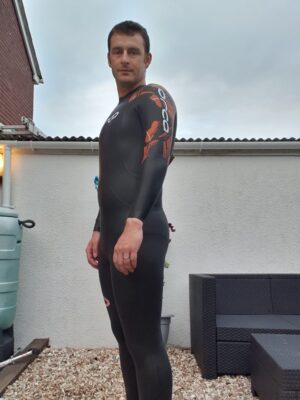
Once on it is very noticeable how flexible the suit is and how much freedom of movement that you have. The wetsuit I have been using is an Orca S4 which now feels very stiff and restrictive when compared to the S7.
I took the suit off and on a number of times to simulate transition. Due to the Hydrolite panels the suit came off really easily, this is a fantastic advantage when racing.
First swim in the Orca S7 wetsuit
Due to the sea conditions my first swim in this wetsuit was a very short outing. Only 10 minutes but I was excited to try this wetsuit out so had to go in. Even though at this point I was very impressed with the warmth and the flexibility of the suit. Despite getting pummelled by the 4ft swell the wetsuit wasn’t emptying and refilling with cold water like my previous suit would. This helped to keep me at a very comfortable temperature.
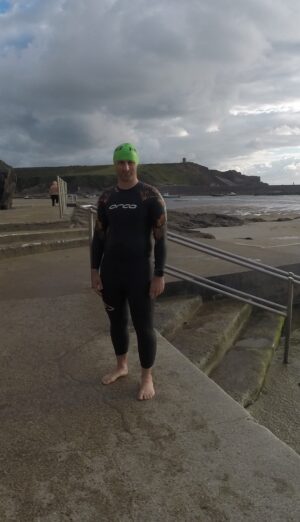
Not being the greatest swimmer, I rely heavily on the buoyancy of the wetsuit to keep my lower body up. The S7 didn’t disappoint there is a lot of buoyancy around the hips and the legs to keep me at the surface.
If you are struggling with swimming training through the winter have you considered trying buoyancy swim shorts? Read our explanation on why buoyancy swim shorts work and they are perfect for triathlon swimmers used to wearing a wetsuit.
Design of the wetsuit
The panelling of the wetsuit is designed to give you floatation where you need it. You get 5mm of neoprene around the lower body, tops of the legs and the bum where the heaviest part of the body is. This gives you lift in the water helping keep your lower body at the surface. This improved position in the water helps you cover more distance more quickly and efficiently. There is 3 and 2mm around the shoulders and arms giving you maximum flexibility.
All the seams are welded, they are glued and stitched on the inside. This means that it doesn’t let water in through the seams which keeps you warmer for longer. With the key points critically taped to reinforce the seams increasing the shelf life of the suit.
The neoprene itself as with all Orca products is Yamamoto neoprene which is a durable, lightweight and high-performance material. Yamamoto neoprene is a limestone sourced rubber which has several improved properties over oil derived neoprene.
Specification of the Orca S7 wetsuit
- Nitrogen gas blown rubber that increases the insulation of the wetsuit, making it warmer.
- A 23% higher closed-cell structure than oil derived neoprene, making it more buoyant.
- Maximum elongation of over 480%, whereas human skin stretches only up to 60 to 70%.
- 95% water impermeable whereas oil derived standard is nearly 70%.
On the outside of the wetsuit the Neoprene has a NANO SCS (Super Composite Skin) coating, to reduce friction and increase speed through the water. Orca uses Yamamoto Corporation’s latest Nano SCS for an even lower drag co-efficient, ensuring you can swim as fast as possible, less friction = more speed.
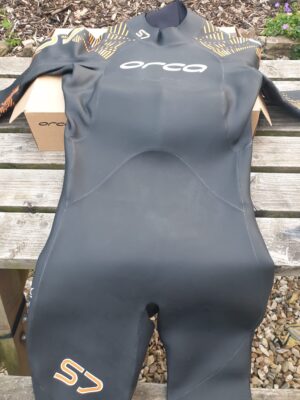
The infinity skin inner lining is a nylon coating which incorporates bamboo fibres to provide greater flexibility. It maintains body heat longer and reduces bad odours and the presences of bacteria in the neoprene. It is also made from natural eco-friendly materials to prevent the appearance of skin irritation and care for the environment.
The neckline of the suit is low to reduce / prevent friction which in turn will prevent any abrasion on the skin.
The panels in the lower legs are made from Yamamoto’s Hydrolite technology. This is an extremely flexible neoprene which allows you to pull off the suit easily without causing any damage. Results from testing were speeding up transitions.
Comfort of the Orca S7 wetsuit
The suit is extremely comfortable the infinity skin inner lining is soft to the touch and non-abrasive. Whilst using this wetsuit I didn’t experience any chafing around the neck. I didn’t even need to wear any lubricant. The flexibility of the suit gave me complete freedom of movement.
Durability of the wetsuit
The S7 seems to be very durable but as with all wetsuits it needs to be well looked after. Such as putting the wetsuit on carefully (it is supplied with a pair of cotton gloves to prevent snagging with fingernails) and rinsing the suit with fresh water after use.
Orca S4 vs Orca S7
The majority of my swims were at my local beach so it is hard to draw direct comparisons from these swims as the condition can be so variable. However, in general comparing my resent swims in the Orca S7 to my swims over the same period last year in my Orca S4 my metrics have improved. Last year I was consistently swimming at a pace of just over 2:00 mins per 100yds. Now my pace is around 1:52 min per 100yds. Part of this improvement may have been due to general fitness levels increasing. As I have done less swimming compared with last year I’m convinced that a large part of this improvement is due to the wetsuit itself. It has improved my body position and the increased flexibility in the upper body increasing my efficiency in the water.
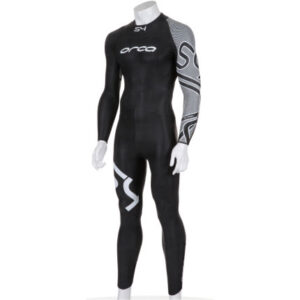
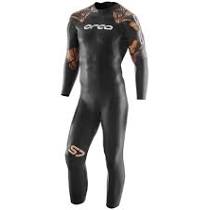
However, the most noticeable improvement on my Orca S4 was the flexibility of the suit. I didn’t feel any restriction when rotating my arms and shoulders through the stroke.
Performance of the Orca S7
I had the opportunity to take part in the Exmoor swim which is at Wimbleball reservoir on Exmoor. This was the first time that I have swum in a freshwater lake. I only noticed a slight difference in my buoyancy swimming in the freshwater compared to salt water. The wetsuit coped well helping me maintain my body position at the surface. This can be shown by my average pace being 1:52 min per 100yds over the 2km course. Which has been the average pace on my recent sea swims.
Summary of Orca S7 Wetsuit Review
Overall, it’s a great suit. It looks good, its robust, really well sized which I was able to get right the first time and most importantly it feels fantastic in the water.
Perfect as an entry level triathlon / swimming wetsuit.
James Williams – Trivelo Test Associate
Would I recommend this wetsuit? Yes, I would. I started using this wetsuit in July when my only option to swim was in the sea. I managed to get out quite a few times in different conditions. Overall I found that the wetsuit improved my body position. The flexibility in the upper body allowed me to concentrate on my stroke and improve my technique. This eventually led me to participating in my first open water swimming event where I swam 2km which is the furthest I have every swum.
See video review of the Orca S7 wetsuit
Hear directly from James and his review.
Best Price for the Orca S7 wetsuit
Buy the Orca S7 wetsuit for £183 direct from Orca in their Amazon store
Alternatives to the Orca S7 triathlon wetsuit
Orca Equip – read the full review of the Orca Equip triathlon wetsuit
Orca 3.8 – read the full review of the Orca 3.8 triathlon wetsuit
Zone 3 Vanquish – read the full review of the Zone 3 Vanquish triathlon wetsuit
For a full round-up read the 15 Best Triathlon Wetsuits 2023 – Complete Buyers Guide from £100 to £1000 . Excellent views from a range of testers on a breadth of different manufacturers and styles.
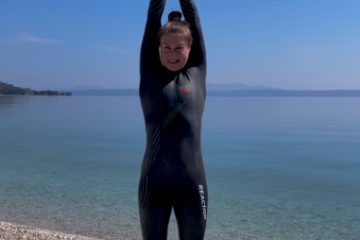
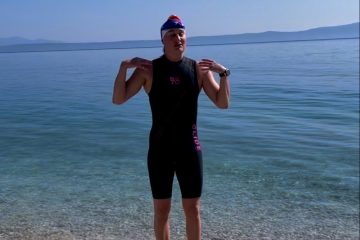
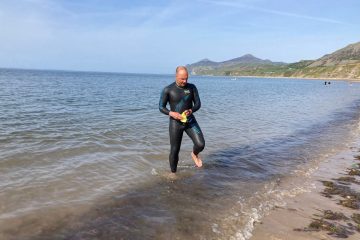
0 Comments